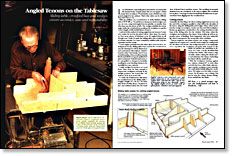Angled Tenons on the Tablesaw
Sliding table crossfeed box and wedges ensure accuracy ease and repeatability
Synopsis: William Krase made a crossfeed box and some purpose-made wedges to use with a sliding table to simplify angled and compound-angled tenons. The wedges establish the tenon angle, while the crossfeed box positions the workpiece to get the correct length, width, and thickness of tenon. A detailed drawing shows how the system works, and Krase steps readers through making tenons angled in one plane and two.
Lots of furniture—especially pieces intended to accommodate the human body—require joints that are not square. Chairs may have as many as 16 such joints, some of which are compound (angled in two planes). That’s why chairs can be difficult. They don’t have to be.
With my addition of a crossfeed box to Kelly Mehler’s sliding table and the use of purpose-made wedges, you can cut even compound-angled tenons quickly, accurately, time after time (see the photo at left). The wedges establish the tenon angle while the crossfeed box positions the workpiece to get the correct length, width and thickness of tenon.
I arrived at this method of cutting angled tenons because I wanted to make the stool in the photo below. Since then, I’ve used it on four more pieces of furniture—over 60 angled joints in all. Though now I wish I’d made the sliding table and crossfeed box of a better material, I’ve been completely satisfied with both the apparatus and the results.
I used regular particleboard (the kind often used for floor underlayment) for the sliding table’s base and for the crossfeed box. Particleboard is what I had handy, but if I were to build another, I’d use medium-density fiberboard (MDF) or a good-quality birch plywood instead. Particleboard seems to be susceptible to changes in humidity, resulting in some binding whenever the humidity becomes extreme.
I make wedges for projects as I need them. They must be long enough to support the workpiece securely in the upright position. I’ve found that 1-ft. sections of 2x stock work well.
To make the thumbscrews that fasten the crossfeed box to the sliding table, I bought a length of -in. by -in. brass strip (from a hobby shop), cut pieces to size and soldered them into the head slots of slotted brass machine screws. The resulting homemade thumbscrews are oversized, so it’s easy to tighten the crossfeed box in place. I use large washers beneath the thumbscrews to prevent them from digging into the crossfeed box.
From Fine Woodworking #99
For the full article, download the PDF below:
Fine Woodworking Recommended Products

Freud Super Dado Saw Blade Set 8" x 5/8" Bore

Olfa Knife

Compass





















Log in or create an account to post a comment.
Sign up Log in